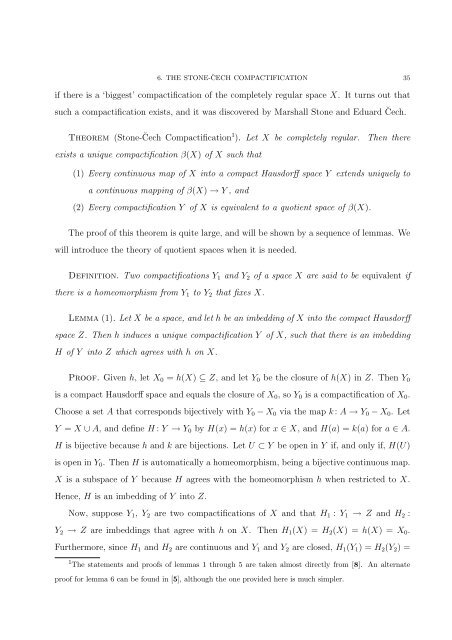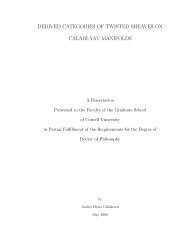FIVE MAJOR RESULTS IN ANALYSIS AND TOPOLOGY Aaron ...
FIVE MAJOR RESULTS IN ANALYSIS AND TOPOLOGY Aaron ...
FIVE MAJOR RESULTS IN ANALYSIS AND TOPOLOGY Aaron ...
You also want an ePaper? Increase the reach of your titles
YUMPU automatically turns print PDFs into web optimized ePapers that Google loves.
6. THE STONE- ˘ CECH COMPACTIFICATION 35<br />
if there is a ‘biggest’ compactification of the completely regular space X. It turns out that<br />
such a compactification exists, and it was discovered by Marshall Stone and Eduard ˘ Cech.<br />
Theorem (Stone- ˘ Cech Compactification 1 ). Let X be completely regular. Then there<br />
exists a unique compactification β(X) of X such that<br />
(1) Every continuous map of X into a compact Hausdorff space Y extends uniquely to<br />
a continuous mapping of β(X) → Y , and<br />
(2) Every compactification Y of X is equivalent to a quotient space of β(X).<br />
The proof of this theorem is quite large, and will be shown by a sequence of lemmas. We<br />
will introduce the theory of quotient spaces when it is needed.<br />
Definition. Two compactifications Y1 and Y2 of a space X are said to be equivalent if<br />
there is a homeomorphism from Y1 to Y2 that fixes X.<br />
Lemma (1). Let X be a space, and let h be an imbedding of X into the compact Hausdorff<br />
space Z. Then h induces a unique compactification Y of X, such that there is an imbedding<br />
H of Y into Z which agrees with h on X.<br />
Proof. Given h, let X0 = h(X) ⊆ Z, and let Y0 be the closure of h(X) in Z. Then Y0<br />
is a compact Hausdorff space and equals the closure of X0, so Y0 is a compactification of X0.<br />
Choose a set A that corresponds bijectively with Y0 − X0 via the map k: A → Y0 − X0. Let<br />
Y = X ∪ A, and define H : Y → Y0 by H(x) = h(x) for x ∈ X, and H(a) = k(a) for a ∈ A.<br />
H is bijective because h and k are bijections. Let U ⊂ Y be open in Y if, and only if, H(U)<br />
is open in Y0. Then H is automatically a homeomorphism, being a bijective continuous map.<br />
X is a subspace of Y because H agrees with the homeomorphism h when restricted to X.<br />
Hence, H is an imbedding of Y into Z.<br />
Now, suppose Y1, Y2 are two compactifications of X and that H1 : Y1 → Z and H2 :<br />
Y2 → Z are imbeddings that agree with h on X. Then H1(X) = H2(X) = h(X) = X0.<br />
Furthermore, since H1 and H2 are continuous and Y1 and Y2 are closed, H1(Y1) = H2(Y2) =<br />
1 The statements and proofs of lemmas 1 through 5 are taken almost directly from [8]. An alternate<br />
proof for lemma 6 can be found in [5], although the one provided here is much simpler.
















